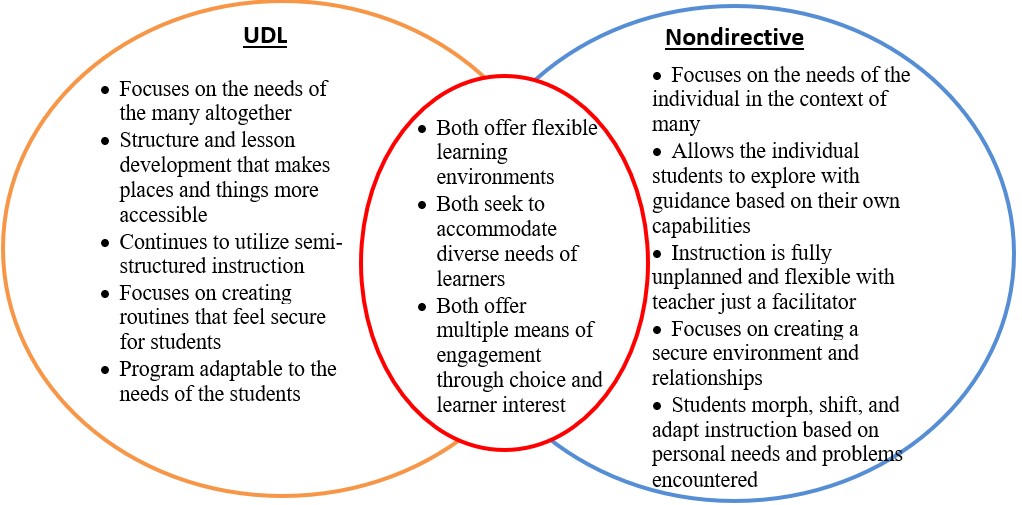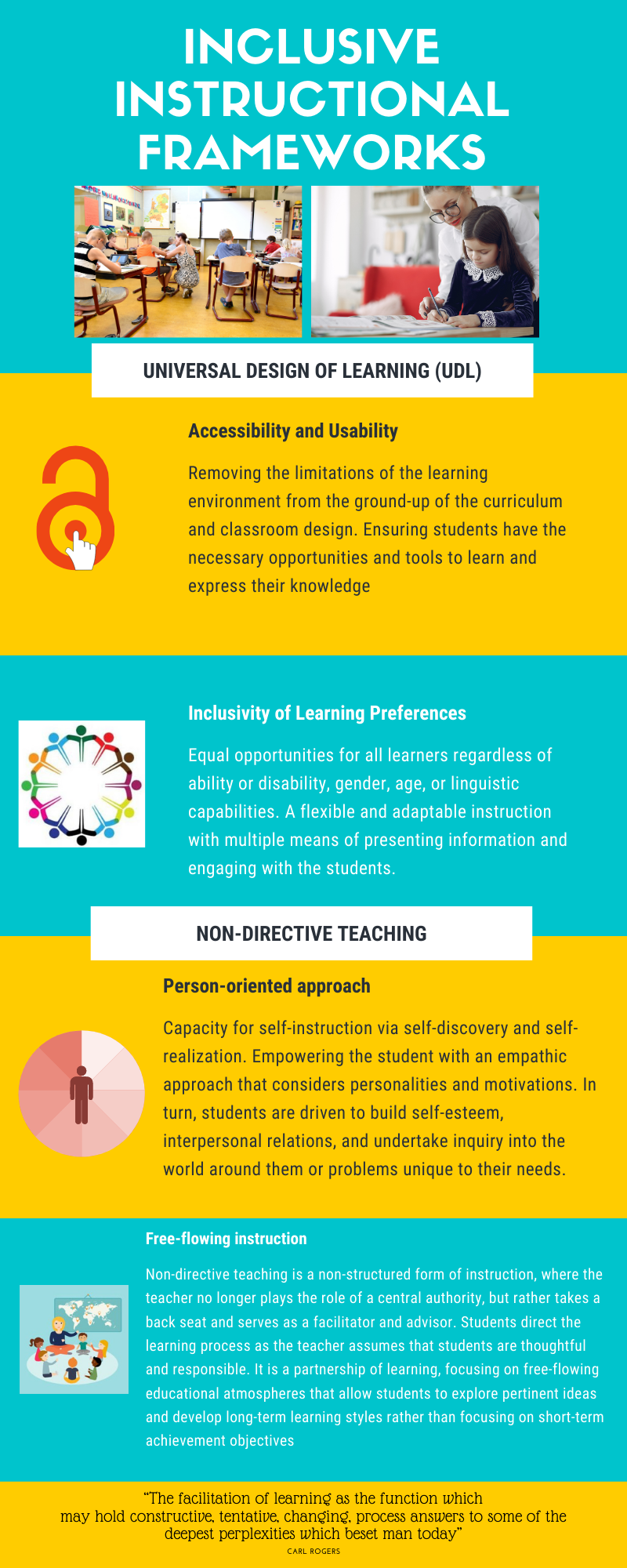Traditional education and instructional approaches in the classroom have long been considered ineffective at appealing to all groups of students. The systemic, standardized traditional education system struggles with inclusivity and equal opportunities, as well as providing students with soft but critical skills of independence and self-realization. Universal design for learning (UDL) and non-directive teaching are two educational frameworks that shift the status quo and adopt unorthodox formats to instructional paradigms. This paper seeks to provide backgrounds on the frameworks and offer an in-depth compare and contrast between them.
Universal Design for Learning Overview
The universal design for learning (UDL) is a framework based on universal design principles in architecture, with the underlying premise removing limitations of the learning environment rather than attempt to addressing learning limitations. The key is to design acceptable content and deliver it in an accessible learning environment so that the instructional experience can be achieved regardless of the individual learning abilities. Therefore, in simple terms, it is a curricula design technique aimed at minimizing implications of learner differences. The UDL framework has been gaining traction among educators as an effective solution to narrowing the gap between learner ability and individual differences (Al-Azawei et al., 2016).
UDL is a framework of instruction that seeks to be inclusive of learning preferences, thus reducing barriers in education. This is particularly relevant for students with disabilities. While reasonable accommodation under the Americans with Disabilities Act (1990) are used to address some of the needs of students with disabilities, both physical and learning, they may create extra steps and barriers. Accommodations are added after the instructional setting, curriculum, and teaching methods had already been designed. That is the objective of UDL, to develop educational instruction from the ground up with these various considerations and accommodations in mind, ones which are appropriate and actually help the students. The key ideas for UDL is access for all individuals (Black et al., 2015).
UDL is a set of principles for designing curriculum which provides equal opportunities for all learners, with considerations of ability, disability, gender, age, and cultural or linguistic background. The framework is based on comprehensive research of learner differences and is grounded in the following three principles:
- Multiple means of representation – information is presented in a variety of methods, such as auditory, visual, potentially sensory – offering a range of means to support.
- Multiple means of action and expression – learners are offered variable ways to demonstrate their knowledge and skills. i.e., in a classroom setting, a choice of assignments may be presented to be completed for homework.
- Multiple means of engagement – inciting learner interest by offering choice of content and tools as well as varying levels of difficulty (Al-Azawei et al., 2016).
Another aspect to consider is the concept of usability, which is often interchanged with accessibility. However, it is not the same and it is important to provide both under UDL. For example, a student with a disability be able to access a web resource, but they will not be able to apply them efficiently. Usability ensures that the instructional materials can be effectively utilized with the satisfaction of a student (Black et al., 2015). Therefore, UDL encompasses instructional modalities to learning and promotes the best teaching strategies to enhance the learning process. The curriculum is based on individual learning preferences of the students in an environment that is flexible, thus supporting variability among learners and enhancing engagement rather than simply teaching a subject.
Nondirective Teaching Overview
The basis of a nondirective teaching model is that it is a person-oriented approach aimed at helping students develop the capacity for self-instruction through the means of realizing of the person’s innate potential via self-discovery and self-understanding (American Psychological Association, n.d.). The model of instruction of nondirective teaching focuses on the learner at the center, based on the person-centered therapy approach developed by renowned psychologist Carl Rogers in the 1940s. Similar to the therapy technique which diverges from traditional models towards an empathic approach that empowers and motivates the client, non-directive teaching seeks to empower the student. Instruction is based on human relations rather than the subject matter at hand, with students in the classroom and teachers working together in partnerships of learning. Often such classrooms consist of free-flowing, non-structured learning and atmosphere to help students explore pertinent ideas and develop long-term learning styles in comparison to short-term content objectives (Joyce et al., 283).
Nondirective teaching offers an approach where personalities and emotions of students are taken into account due to the person-centered nature. The key to this methodology is to emphasize with students to nurture and develop thoughts but offer both positive and negative feedback essential to development. In a nondirective classroom, the teacher is a facilitator, with teachers respectful and operating under the assumption that students are thoughtful and responsible, with the ability to identify and find solutions to problems which arise. As stated by Rogers who advocated for students taking a central role in a classroom, “the facilitation of learning as the function which may hold constructive, tentative, changing, process answers to some of the deepest perplexities which beset man today” (Zhang, 2014).
The nondirective model typically follows a specific model:
- Phase I – define helping situation
- Phase II – explore the problem
- Phase III – develop insight
- Phase IV – planning and decision making
- Phase V – Integration
Nondirected teaching indicates that teachers abandon the traditional role of a decision-maker and a figure of authority and control. Instead, communication with students is equal, taking on a role of an advisor to provide psychological help and emotional guidance for the students. Teachers should attempt to reflect, clarify, and foster understanding, but never seek to interpret or attempt to change or influence attitudes (Wang, 2019) During the instructional process, students learn to be connected to teachers and counselors for support to reflect on themselves, taking appropriate stems to build self-esteem and interpersonal relations. Students undertake investigations, and often utilize ICT resources such as online course and other means of distance learning which notably can also be provided in a nondirective fashion (Joyce et al., 298).
Rationale
UDL was selected as it is one of the key instructional frameworks gaining traction in the context of diverse classrooms and greater emphasis on learning styles and learning abilities of students. The approach is also very appealing as it cares for the needs of all the students, particularly those who are often disadvantaged in the learning process due to disabilities or unique learning needs. It remains a brilliant and effective solution to addressing diverse students needs in a classroom setting, allowing for flexibility and adaptability.
Non-directive teaching was selected largely for its uniqueness, its ability to differentiate from the traditional and convention-bound methodologies. It is a paradigm that most, even those who do not accept it necessarily, see as something unorthodox. Furthermore, one can argue that non-directive teaching has significant application, extending beyond the classroom and providing skills to students to function in any social situation. It was interesting to compare the free-flowing, unstructured learning of non-directive teaching to other forms of instruction that albeit may be different from traditional models, continue to have some level of boundaries and structure.
Comparison
These two unique educational frameworks are similar in many ways. Both of them strive to create flexible learning environments, ones in which students will feel comfortable and their ability to learn will be enhanced. This is done through accommodating diverse needs of the learners, UDL taking an approach of offering a variety of learning methods and representations, while nondirective teaching focuses more on working with individual students. Finally, both frameworks highly support and emphasize student choice of engagement with the curriculum to cultivate learner interest. However, there are fundamental differences. UDL while promoting flexibility still values a structured approach, with a set curriculum and lesson planning. It simply focuses on the incorporating the needs of the variety of students altogether. Nondirective teaching has no structure and is free-flowing and unplanned. Learner needs are accommodated but throughout the classroom/instruction based on individual students and needs that arise. While UDL emphasizes routines, securing students to ensure they are comfortable in them and can engage in the learning process, nondirective teaching emphasizes a safe environment and gives strong attention to safe relationships with instructors who can faciliate and guide the students in their inquiry.
Both frameworks are complex, and notably not applicable to every type of classroom or curriculum. UDL is more adaptable to the typical classroom of any age, demographics, and size. Meanwhile, the nondirective approach ultimately requires the attention of the teacher to individual students; therefore, classroom sizes should be small in reality. The nondirective teaching method is likely most practical in settings with young children where exploration is encouraged or perhaps in certain courses for older children or university where the key is not to objectively learn the curriculum but to explore abstract concepts or ideas. Both UDL and nondirective teaching are effective in the context of the modern online learning, with students provided multiple resources and variations of exploring the material and learning the information.


References
Al-Azawei, A., Serenelli, F., & Lundqvist, K. (2016). Universal Design for Learning (UDL): A content analysis of peer reviewed journals from 2012 to 2015. Journal of the Scholarship of Teaching and Learning, 16(3), 39-56. Web.
American Psychological Association. (n.d.). Nondirective teaching model. Web.
Black, R. D., Weinberg, L. A., & Brodwin, M. G. (2015). Universal Design for Learning and Instruction: Perspectives of Students with Disabilities in Higher Education. Exceptionality Education International, 25(2). Web.
Joyce, B., Weil, M., & Calhoun, E. (2015). Models of teaching (9th ed.). Pearson
Teaching Excellence in Adult Literacy. (n.d.). TEAL center fact sheet no. 2: Universal design for learning. Web.
Wang, C. (2019). Comparisons between non-directive teaching model and other teaching Models. Web.
Zhang, Y. (2015). On the possible implementation of nondirective teaching for English class in post secondary public schools in China. Web.
